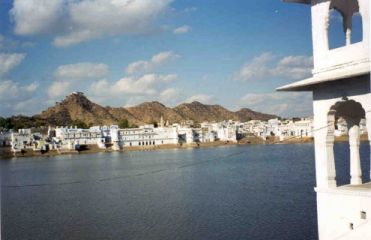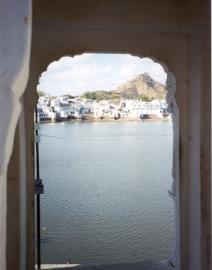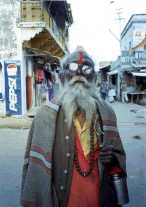|
 PUSHKAR PUSHKAR
I loved Pushkar ... miniscule in size, it was a peaceful, picturesque
hamlet of roughly 12,000 inhabitants and 400 temples, encircling the
tranquil Pushkar Lake. It lies 11 km from Ajmer, and is separated from
Ajmer, by the Nag Pahar (Snake Mountain).
An important pilgrimage centre, and a favourite traveller hangout (I
thought some may have travelled up north from Goa!) and the home of one of
the world's most famous camel and cattle fairs, held in the early winter,
Pushkar is the site of the only temple in India dedicated to Brahma.
It's a relaxing place - you can sit by the lake for hours, lulled by the
gentle breezes, and the distant temple bells, watching the pilgrims on the
numerous ghaats on the lake shore offer their prayers, and scatter rose
petals in the waters. (A warning about rose petals - unless you're
prepared to part with some hard cash, don't accept rose petals, flowers,
garlands, and/or coconuts from children, and temple attendants.)
Photography is not permitted on the ghats, and signs advising tourists as
to their dress and mode of conduct are put up everywhere. Too bad I
couldn't enter quite a few Jain temples, since only Jains are permitted to
enter these. On more than one occasion, I saw signs on temple doors that
read: "foreigners not permitted". In a secular mode though, Pushkar and
its people are comfortably geared to Western visitors. This village is as
close a vegetarian can get to being in heaven - being a holy Jain place,
meat and alcohol are banned.

Savitri Temple
This is the temple dedicated to Lord Brahma's first wife. It is located on
the hill behind the Brahma temple, and one has to climb a long series of
steps to reach the destination. It gives a panoramic view of the lake and
surrounding sand dunes.
In Pushkar, I saw cows & buffaloes - not an uncommon sight in India at
all. But because this is a holy pilgrim centre, and cows in the Hindu
religion are worshipped and considered sacred, I had expected them to be
treated a bit more than just humanely by the populace. Much to my dismay,
I saw many of these poor animals in a pathetic state ... weak, bones
protruding visibly, and chewing not on grass but sheets of newspaper and
cardboard that they managed to salvage from garbage bins, local dumps, and
road sides. Though there were a few lucky ones, that sat fattened by the
temple doors, by and large, the ones that ambled by the bus stand,
market, temples & shops, were shooed away by everybody including the local
merchants and temple priests. This same sight (dogs, cats, old camels
included) was repeated pretty much all over Rajasthan, and as an animal
lover,
 I
have to admit I was disturbed on several occasions on seeing the plight of
these animals. On the other hand, if one were to rationalize this
existence, this is a land where life for many is a matter of basic
instinct and survival - a hand to mouth existence... so religion or no
religion, if humans beings are faced with fighting daily challenges, where
is the inclination to accommodate animal rights? Sigh, one of the many
paradox's that make for India. I
have to admit I was disturbed on several occasions on seeing the plight of
these animals. On the other hand, if one were to rationalize this
existence, this is a land where life for many is a matter of basic
instinct and survival - a hand to mouth existence... so religion or no
religion, if humans beings are faced with fighting daily challenges, where
is the inclination to accommodate animal rights? Sigh, one of the many
paradox's that make for India.
... of holy men and begging bowls
I met this gentleman as I was ambling through the innards of Pushkar's
local bazaar. He stopped me and asked if I had a rupee to give him. In
return, I could photograph him. Sure, I said, I was game for it. He arched
his back and looked tall in an instant, and made sure his shawl and
begging bowl were in place. I clicked a picture of him, and handed him his
dues. As I walked away, he drawled to me in the smoothest English ever:
"Gotta cigarette?"
How to make your wallet lighter in Pushkar:
If you dig statues of Indian gods and goddesses, holy beads and threads,
vessels, and other brass and copper ware, Pushkar is the place for you.
Like other places in Rajasthan, you also get paintings, embroidered
panels, artifacts and other handicrafts here.
Recommendation for your Taste-Buds:
Surrounding Pushkar are fields of rose bushes. Grown because of the high
demand for rose petals used during worship, the petals are also used to
make 'gulkand' or rose jam. It is here that I saw several peacocks,
who apparently come to savour this delicacy much to the annoyance of the
farmers.
And as you stroll through the bazaar, you see cooks frying round discs of
flour, soaking them in a sweet syrup, and stacking them to make giant
conical mounds of 'malpuas' - a dessert Pushkar is well known for.
Home :
Rajashthan :
Jaipur :
Jaisalmer :
Pushkar : Jodhpur :
Bombay : Goa
: Rajashtani cuisine |